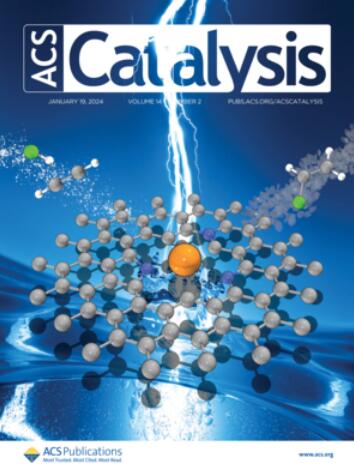Bidentate Ligand-Engineered MOF-Based Cu Single-Atom Catalyst for Selective Conversion of Organic Azides into Unsymmetrical Carbonyls via Functionalized Building Units and Atomic Regulation
IF 13.1
1区 化学
Q1 CHEMISTRY, PHYSICAL
引用次数: 0
Abstract
The construction of unsymmetrical molecular structures has been a long-standing challenge in organic chemistry, particularly in the field of unsymmetrical carbonyls, which requires precise control over reaction selectivities. In this study, we introduced an innovative protocol that facilitates the one-step, completely selective preparation of a series of unsymmetrical carbonates, ureas, and carbamates from conventional carbonyl azides with the complete dissociation of the azido group. Leveraging the structural programmability of metal–organic frameworks (MOFs), we implemented a dual-modification strategy involving: (i) precise tailoring of functional building blocks with Schiff-base linkage to construct the microenvironment of the scaffold and (ii) coordination of copper species onto the predesigned基于mof的双齿配体铜单原子催化剂通过功能化构建单元和原子调控选择性地将有机叠氮化物转化为不对称羰基
不对称分子结构的构建一直是有机化学领域的一个长期挑战,特别是在不对称羰基领域,这需要精确控制反应的选择性。在这项研究中,我们引入了一种创新的方法,可以一步、完全选择性地从传统的羰基叠氮化物中制备一系列不对称的碳酸盐、脲和氨基甲酸酯,同时叠氮化物基完全解离。利用金属有机框架(mof)的结构可编程性,我们实施了一种双重修饰策略,包括:(i)使用希夫碱链接精确定制功能构建块以构建支架的微环境;(ii)将铜物种配位到预先设计的N,N双齿配体上,最终制造出具有特定活性的基于mof的Cu单原子催化剂。此外,密度泛函理论(DFT)计算表明,亲核试剂的活化和随后对羰基的攻击参与了速率决定步骤。该方案不仅允许铜配位环境的微调调制,而且保证了铜单原子的稳定固定。这项工作强调了单原子催化剂在有机叠氮化物转化为不对称羰基中的关键作用,以及它们在有机合成中的反应性和选择性控制方面的关键贡献。
本文章由计算机程序翻译,如有差异,请以英文原文为准。
求助全文
约1分钟内获得全文
求助全文
来源期刊

ACS Catalysis
CHEMISTRY, PHYSICAL-
CiteScore
20.80
自引率
6.20%
发文量
1253
审稿时长
1.5 months
期刊介绍:
ACS Catalysis is an esteemed journal that publishes original research in the fields of heterogeneous catalysis, molecular catalysis, and biocatalysis. It offers broad coverage across diverse areas such as life sciences, organometallics and synthesis, photochemistry and electrochemistry, drug discovery and synthesis, materials science, environmental protection, polymer discovery and synthesis, and energy and fuels.
The scope of the journal is to showcase innovative work in various aspects of catalysis. This includes new reactions and novel synthetic approaches utilizing known catalysts, the discovery or modification of new catalysts, elucidation of catalytic mechanisms through cutting-edge investigations, practical enhancements of existing processes, as well as conceptual advances in the field. Contributions to ACS Catalysis can encompass both experimental and theoretical research focused on catalytic molecules, macromolecules, and materials that exhibit catalytic turnover.
 求助内容:
求助内容: 应助结果提醒方式:
应助结果提醒方式:


